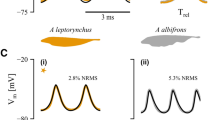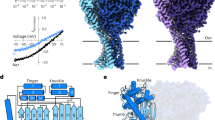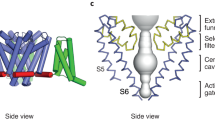Abstract
IN extension of the “sodium theory” of nerve impulse production1, a number of authors have described excitable membranes in which normal inward action currents are carried chiefly by calcium ions in crustacean muscles2–6 and amphibian heart tissue7. It has been suggested that some gastropod giant neurones have “calcium spikes”8,9. Oomura et al.8 showed that supra-oesophageal ganglion cells in Onchidium continue to produce spikes in media free from sodium or calcium, but become inexcitable if both sodium and calcium ions are removed from the perfusing solution. This behaviour is also seen in Aplysia giant neurones and, together with the quantitative effects of varying external ion concentrations, suggests that both sodium and calcium act as carriers of current during the normal action potential.
This is a preview of subscription content, access via your institution
Access options
Subscribe to this journal
Receive 51 print issues and online access
$199.00 per year
only $3.90 per issue
Buy this article
- Purchase on Springer Link
- Instant access to full article PDF
Prices may be subject to local taxes which are calculated during checkout
Similar content being viewed by others
References
Hodgkin, A. L., and Katz, B., J. Physiol., 108, 37 (1949).
Fatt, P., and Katz, B., J. Physiol., 120, 171 (1953).
Hagiwara, S., and Naka, K., J. Gen. Physiol., 48, 141 (1964).
Parnas, I., and Abbott, B. C., Amer. Zoologist, 4, 284 (1964).
Takeda, K., Biol. Bull., 129, 426 (1965).
Fatt, P., and Ginsborg, B. L., J. Physiol., 142, 516 (1958).
Niedergerke, R., and Orkand, R. K., J. Physiol., 184, 291 and 312 (1966).
Oomura, Y., Ozaki, S., and Maéno, T., Nature, 191, 1265 (1961).
Gerasimov, V. D., Kostyuk, P. G., Maiskii, V. A., Biofizika, 10, 447 (1965).
Arvanitaki, A., and Chalazonitis, N., J. Physiol. Par., 50, 122 (1958).
Tauc, L., J. Gen. Physiol., 45, 1077 (1962).
Dettbarn, W. D., Higman, H., Rosenberg, P., and Nachmansohn, D., Science, 132, 300 (1960).
Narahashi, T., Moore, J. W., Scott, W. R., J. Gen. Physiol., 47, 965 (1964).
Nakamura, Y., Nakajima, S., Grundfest, H., J. Gen. Physiol., 48, 985 (1965).
Hagiwara, S., and Nakajima, S., J. Gen. Physiol., 49, 793 (1966).
Takata, M., Moore, J. W., Kao, C. Y., and Fuhrman, F. A., J. Gen. Physiol., 49, 977 (1966).
Kerkut, G. A., and Gardner, D. R., Comp. Biochem. Physiol., 20, 147 (1967).
Author information
Authors and Affiliations
Rights and permissions
About this article
Cite this article
JUNGE, D. Multi-ionic Action Potentials in Molluscan Giant Neurones. Nature 215, 546–548 (1967). https://doi.org/10.1038/215546a0
Received:
Published:
Issue Date:
DOI: https://doi.org/10.1038/215546a0
This article is cited by
-
Presynaptic Na/Ca action potentials in unmyelinated axons of olfactory cortex
Pfl�gers Archiv European Journal of Physiology (1988)
-
Different spike mechanisms in axon and soma of molluscan neurone
Nature (1974)
-
Calcium currents in snail neurones
Pfl�gers Archiv European Journal of Physiology (1974)
-
Modification to the Hodgkin-Huxley equation as applied to the somatic membrane of mollusk giant neurons
Neurophysiology (1974)
-
Action of calcium on the somatic membrane of mollusk giant neurons
Neurophysiology (1974)
Comments
By submitting a comment you agree to abide by our Terms and Community Guidelines. If you find something abusive or that does not comply with our terms or guidelines please flag it as inappropriate.



